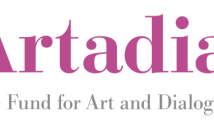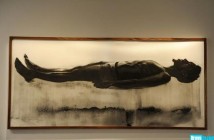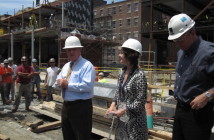In addition to the massive gallery hopping in I did in the 798 District I also spent some time in the relatively new gallery area of Caochangdi. This is an old neighborhood farther out of the city that has recently been transformed into another arts district. A lot of the galleries and artists who could no longer afford to be in 798 have moved out here. It is a bit more rough and tumble. The village is compact and teeming with people. Construction is taking place everywhere. The village itself is set to be torn down sometime in the future so there is a frenetic nature to the place. The government has taken to building artist spaces and galleries around the village center. It is a really interesting area and I found it to be more exciting than 798.
The galleries are fewer and more widespread that in 798 but with a car and a sense of purpose you can see some great art. One of the more amazing spaces I came across was the Swiss Galerie Urs Meile. They have two spaces. One is in Lucerne and the other is here in Caochangdi. I believe that they were one of the first to move out here. They occupy some pretty cool spaces that were designed by the architect and art world superstar Ai Wei Wei (his name crops up everywhere in Beijing). The gallery also runs an artist residency program in their compound. The show they had up while I was visiting was for He Yunchang (A Chang) and titled "The Wings of Live Art." I wasn't quite sure what to make of his work. He is a performance artist and painter. For this piece he had a rib removed from his body. The rib is then made into a necklace. The two main galleries are full of paintings that are inspired by the process of removal, and photographs of several women in his life wearing the necklace. While using the body as an art form is certainly not a new or novel thing, there was something very disconcerting about this work. What does the removal of the rib represent?
He Yunchang's performances are predominantly done in public. Here, since it involved major surgery, it took place behind closed doors. And, coincidentally, it took place on the opening day of the Olympic Games in Beijing. It is the privacy of the act that shifts his work away from performance and towards documentation. The paintings are representations of the process and there are photographs that detail the instruments used during the procedure. He purports to be referencing both Western myth (Adam's rib) and Chinese but there isn't really a way into the work through these respective mythologies. I wondered if that was intentional. Certainly, particular viewers would read the work according to their specific cultural references but I was left wondering what exactly the purpose was? The reaction of people who were with me was pretty cynical. It came down to spending money. He performed this rib removal simply because he could. The artifact left over, his rib, was then transformed into a gold necklace the shape of a double-headed mythological animal with the two heads positioned at opposite ends of the rib. This necklace sits in the center of the gallery on a red cushion. A sculptural remnant of his performance. And although I was initially non-plussed by the work I find myself revisiting it in my mind. There was something about the artifact and the performance that I am finding intriguing, probably because it disturbed me.
Next we headed to the Three Shadows Photography Art Center. First of all, this space is huge. The galleries go on and on and on. The Center was founded in 2007 and is the first contemporary art center for photography in China. They have darkrooms, printing services and a video editing studio all situated in another group of buildings designed by Ai Wei Wei. The current exhibition was "Yumen: A 2006-2009 Photography Project" by Zhuang Hui and Dan' er. Zhuang Hui is an internationally recognized photographer who has traditionally photographed in a documentary style, usually doing self portraits pairing himself with people of a particular trade (farmers, soldiers, doctors etc). Dan' er is a painter who has recently teamed up with Zhuang on a series of oil paintings depicting popular online news stories that had been blocked by the mainstream Chinese media. Their current project was really quite fascinating.
The two of them opened a photographic studio in the aging oil-boom city of Yumen (also Zhuang's hometown). The city itself has undergone extreme changes due to the fluctuating success of the oil fields that surround the city. The installation is somewhat historical in that there are a series of photographs and documents telling of Yumen's importance in the early days of the communist regime. The city has fallen on tough times as the oil production has diminished. But the historical data simply serve to set the scene. Once you enter into the main galleries you see what the artists were doing with their photo studio.
Zhuang and Dan' er documented the entire year spent in Yumen. The studio is full of the work created in their photo shop. From identification photos to art photos to group portraits it is a documentation of the population of a town. The walls of the gallery are covered with photographs of the people of Yumen. On one side there are sheets and sheers of ID photographs. The faces are emotionless and tired looking. On the opposite side are the studio portraits. And these are the fantasy pictures. Many of them are of two or more people grouped together and standing in front of a fantastical backdrop (waterfalls, nature scenes, etc). The contrast was really interesting. There is a temptation to think that people living in an environment like Yumen would be perpetually downbeat and miserable but the portraits offer up a glimpse of people who are finding joy in gathering for a photograph. The lighting, props and makeup of the studio transformed these people. There was also a video projection installed that documented several of the people being photographed. The subjects preened and posed, momentarily taken to another place by the camera and the setting. It was fascinating and enjoyable to watch.
Lastly I visited C-Space. C-Space was opened in 2008 and focuses on "recognized and emerging artists" from Europe. Their goal is to bring European artists to China. The exhibit I saw was titled "The Culture of Make Believe." It consisted of a group of tiny sculptures placed before blue screens. Some of the figures are scenes from well known Hollywood productions (there is one from the Wizard of Oz) while others are representative of Greek/Roman gods. While the concept was only moderately interesting I did find the sculptural work superb. The pieces were theatrical and engaging. The gallery was dimly lit with a subtle soundtrack echoing throughout the space. Each piece stood alone atop a spot-lit pedestal. The artist, Sagi Groner, has created miniature "back-stages" to our contemporary cultural illusions. Some were successful and others not so much. Regardless, they were interesting to experience. There was another installation in an adjoining gallery space that was kinda cool. The artist duo Vroegop/Schoonveld filled the space with 200 porcelain discs in the sizes of an LP, an EP, a single, and a DVD/CD. They were spread across the gallery floor, their varied sizes creating an undulating effect. The installation, titled "Pause," was interesting to see but ultimately just a "huh" piece. Nothing really transformational but cool to look at.
"He Yunchang: The Wings of Making Art" was on view until October 31st, 2009 at Galerie Urs Meile. All images are courtesy of the artist and Galerie Urs Meile.
"Yumen 2006-2009: Photography Project" is on view until November 22nd, 2009 at Three Shadows Photography Art Center.
All images are courtesy of the artist and Three Shadows Photography Art Center.
"The Culture of Make Believe" was on view until October 25th, 2009 at C-Space Beijing. All images are courtesy of the artist and C-Space Beijing.



